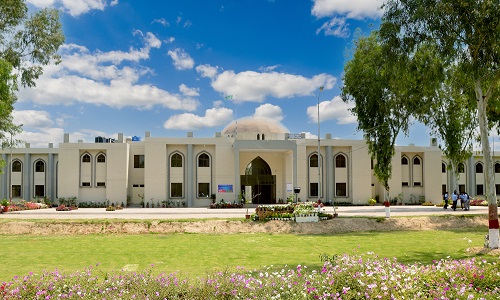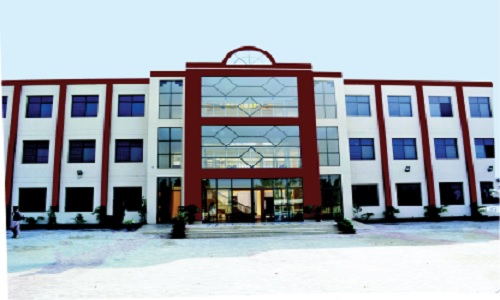Title: Enhancing the Physiological and Biochemical Potential of Praecitrullus fistulosus L. through Synergistic Action of Biochar and Zinc Oxide Nanoparticles. Authors: Sundas Sana, Ayesha Binyamin, Musarrat Ramzan, Jawaria Jameel, Asma Hanif,Zahoor Ahmad, Abeer Hashem, Graciela Dolores Avila-Quezada & Elsayed Fathi Abd-Allah. Year: 2024 Link: https://doi.org/10.1007/s42729-024-01894-8 Abstract: In contemporary farming practices, biochar along with nano-priming of seeds has become a significant application for improving soil fertility, germination, and seedling vigor. A pot experiment was performed in a completely randomized design (CRD) with factorial arrangement and replicated thrice. Biochar was mixed in soil with (0.1%) and (0.2%) per 5 kg pot size for one week before seeds sowing. Zinc oxide nanoparticles were used for the nano-priming of tinda seeds. Round gourd seeds were nano-primed with ZnO NP (20 mg, 40 mg, and 60 mg) and were sown in biochar-mixed soil. Shoot length, root length, and shoot fresh weight were maximum in T3 (0.1% biochar with 60 mg ZnO) as compared to control and other treatment groups. Photosynthetic pigments have not shown any significant increase under treated conditions as compared to control tinda plants. Physiological attributes were significantly increased as compared to non-treated plants. Total soluble sugars and proline were highest in T4 (0.2% biochar with 20 mg ZnO) compared to other treatment groups. Antioxidant enzyme catalase showed an increase in content with T1 (0.1% biochar with 20 mg ZnO), followed by, T2 (0.1% biochar with 40 mg ZnO), T3 (0.1% biochar with 60 mg ZnO) and least in T6 (0.2% biochar with 60 mg ZnO). Maximum peroxidase and superoxide dismutase activity was observed in T6 (0.2% biochar with 60 mg ZnO) as compared to other treatments. Move over, it is recommended to use biochar in soil and green ZnO nanoparticles as priming agents for improvement in the growth and productivity of round gourd plants. |
Title: Effect of methyl jasmonate and GA3 on canola (Brassica napus L.) growth, antioxidants activity, and nutrient concentration cultivated in salt-affected soils. Authors: Subhan Danish, Sundas Sana, Muhammad Baqir Hussain, Khadim Dawar, Hesham S. Almoallim, Mohammad Javed Ansari, Misbah Hareem & Rahul Datta.
Year: 2024 Link:https://doi.org/10.1186/s12870-024-05074-9 Abstract: Salinity stress is a significant challenge in agricultural production. When soil contains high salts, it can adversely affect plant growth and productivity due to the high concentration of soluble salts in the soil water. To overcome this issue, foliar applications of methyl jasmonate (MJ) and gibberellic acid (GA3) can be productive amendments. Both can potentially improve the plant’s growth attributes and flowering, which are imperative in improving growth and yield. However, limited literature is available on their combined use in canola to mitigate salinity stress. That’s why the current study investigates the impact of different levels of MJ (at concentrations of 0.8, 1.6, and 3.2 mM MJ) and GA3 (0GA3 and 5 mg/L GA3) on canola cultivated in salt-affected soils. Applying all the treatments in four replicates. Results indicate that the application of 0.8 mM MJ with 5 mg/L GA3 significantly enhances shoot length (23.29%), shoot dry weight (24.77%), number of leaves per plant (24.93%), number of flowering branches (26.11%), chlorophyll a (31.44%), chlorophyll b (20.28%) and total chlorophyll (27.66%) and shoot total soluble carbohydrates (22.53%) over control. Treatment with 0.8 mM MJ and 5 mg/L GA3 resulted in a decrease in shoot proline (48.17%), MDA (81.41%), SOD (50.59%), POD (14.81%) while increase in N (10.38%), P (15.22%), and K (8.05%) compared to control in canola under salinity stress. In conclusion, 0.8 mM MJ + 5 mg/L GA3 can improve canola growth under salinity stress. More investigations are recommended at the field level to declare 0.8 mM MJ + 5 mg/L GA3 as the best amendment for alleviating salinity stress in different crops. |
Title: Effect of salinity on growth and biochemical responses of brinjal varieties: implications for salt tolerance and antioxidant mechanisms. Authors:Jawaria Jameel, Tauseef Anwar, Saadat Majeed, Huma Qureshi, Ejaz Hussain Siddiqi, Sundas Sana, Wajid Zaman & Hayssam M. Ali. Year: 2024 Link: https://doi.org/10.1186/s12870-024-04836-9 Abstract: Salinity poses significant challenges to agricultural productivity, impacting crops’ growth, morphology and biochemical parameters. A pot experiment of three months was conducted between February to April 2023 in the Department of Botany, The Islamia University of Bahawalpur. Four brinjal (eggplant) varieties: ICS-BR-1351, HBR-313-D, HBR-314-E, and HBR-334-D were selected and assessed for the effects of salinity on various growth and biochemical attributes. The experiment was completely randomized in design with three replicates each. This study revealed that increased salinity significantly reduced the shoot length, root length, and leaf number across all varieties, with maximum adverse effects observed at a 300mM NaCl concentration. Among the tested varieties, ICS-BR-1351 demonstrated superior performance in most growth parameters, suggesting potential salt tolerance. Biochemically, salinity decreased chlorophyll content across all varieties, with the sharpest decline observed at the highest salt concentration. V4 (HBR-334-D) showed a 57% decrease in chlorophyll followed by V3 (HBR-314-E) at 56%, V2 (HBR-313-D) at 54%, and V1 (ICS-BR-1351) at 33% decrease at maximum salt levels as compared to control. Conversely, carotenoid content increased up to -42.11% in V3 followed by V2 at -81.48%, V4 at -94.11%, and − 233% in V1 at 300mM NaCl stress as compared to respective controls. V3 (HBR-314-E) has the maximum value for carotenoids while V1 has the lowest value for carotenoids as compared to the other three brinjal varieties. In addition to pigments, the study indicated a salinity-induced decrease in total proteins and total soluble sugar, whereas total amino acids and flavonoids increased. Total proteins showed a decrease in V2 (49.46%) followed by V3 (36.44%), V4 (53.42%), and V1 (53.79%) at maximum salt concentration as compared to plants treated with tap water only. Whereas, total soluble sugars showed a decrease of 52.07% in V3, 41.53% in V2, 19.49% in V1, and 18.99% in V4 at the highest salt level. While discussing total amino acid, plants showed a -9.64% increase in V1 as compared to V4 (-31.10%), V2 (-36.62%), and V3 (-22.61%) with high salt levels in comparison with controls. Plant flavonoid content increased in V3 (-15.61%), V2 (-19.03%), V4 (-18.27%) and V1 (-27.85%) at 300mM salt concentration. Notably, salinity elevated the content of anthocyanin, lycopene, malondialdehyde (MDA), and hydrogen peroxide (H2O2) across all varieties. Antioxidant enzymes like peroxidase, catalase, and superoxide dismutase also increased under salt stress, suggesting an adaptive response to combat oxidative damage. However, V3 (HBR-314-E) has shown an increase in anthocyanin at -80.00%, lycopene at -24.81%, MDA at -168.04%, hydrogen peroxide at -24.22%, POD at -10.71%, CAT as-36.63 and SOD as -99.14% at 300mM NaCl stress as compared to control and other varieties. The enhanced accumulation of antioxidants and other protective compounds suggests an adaptive mechanism in brinjal to combat salt-induced oxidative stress. The salt tolerance of different brinjal varieties was assessed by principal component analysis (PCA), and the order of salt tolerance was V1 (ICS-BR-1351) > V4 (HBR-334-D), > V2 (HBR-313-D) > V3 (HBR-314-E). Among the varieties studied, ICS-BR-1351 demonstrated resilience against saline conditions, potentially offering a promising candidate for saline-prone agricultural areas. |
Title: Differential responses of chili varieties grown under cadmium stress. Authors:Sundas Sana, Musarrat Ramzan, Samina Ejaz, Subhan Danish, Saleh H. Salmen & Mohammad Javed Ansari. Year: 2024 Link:https://doi.org/10.1186/s12870-023-04678-x Abstract: Heavy metal cadmium (Cd) naturally occurs in soil and is a hazardous trace contaminant for humans, animals, and plants. The main sources of Cd pollution in soil include overuse of phosphatic fertilizers, manure, sewage sludge, and aerial deposition. That’s why an experiment was conducted to analyze the effect of Cd toxicity in Capsicum annuum L. by selecting its seven varieties: Hybrid, Desi, Sathra, G-916, BR-763, BG-912, and F1-9226. Cadmium was spiked in soil with four levels, i.e., (0, 3, 4, and 5 mg Cd kg− 1 of soil) for a week for homogeneous dispersion of heavy metal. Chili seeds were sown in compost-filled loamy soil, and 25-day-old seedlings were transplanted into Cd-spiked soil. Cadmium increasing concentration in soil decreased chili growth characteristics, total soluble sugars, total proteins, and amino acids. On the other hand, the activities of antioxidant enzymes were increased with the increasing concentration of Cd in almost all the varieties. Treatment 5 mg Cd/kg application caused − 197.39%, -138.78%, -60.77%, -17.84%, -16.34%, -11.82% and − 10.37% decrease of carotenoids level in chili V2 (Desi) followed by V4 (G-916), V1 (Hy7brid), V7 (F1-9226), V6 (BG-912), V5 (BR-763) and V3 (Sathra) as compared to their controls. The maximum flavonoids among varieties were in V5 (BR-763), followed by V6 (BG-912), V7 (F1-9226), V3 (Sathra) and V1 (Hybrid). Flavonoids content was decreased with − 37.63% (Sathra), -34.78% (Hybrid), -33.85% (G-916), -31.96% (F1-9226), -31.44% (Desi), -30.58% (BR-763), -22.88% (BG-912) as compared to their control at 5 mg Cd/kg soil stress. The maximum decrease in POD, SOD, and CAT was − 31.81%, -25.98%, -16.39% in chili variety V7 (F1-9226) at 5 mg Cd/kg stress compared to its control. At the same time, maximum APX content decrease was − 82.91%, followed by -80.16%, -65.19%, -40.31%, -30.14%, -10.34% and − 6.45% in V4 (G-916), V2 (Desi), V3 (Sathra), V6 (BG-912), V1 (Hybrid), V7 (F1-9226) and V5 (BR-763) at 5 mg Cd/kg treatment as compared to control chili plants. The highest CAT was found in 5 chili varieties except Desi and G-916. Desi and G-916 varieties. V5 (BR-763) and V6 (BG-912) were susceptible, while V1 (Hybrid), V3 (Sathra), and V7 (F1-9226) were with intermediate growth attributes against Cd stress. Our results suggest that Desi and G-916 chili varieties are Cd tolerant and can be grown on a large scale to mitigate Cd stress naturally. |
Title:Mitigation of bacterial spot disease induced biotic stress in Capsicum annuum L. cultivars via antioxidant enzymes and isoforms. Authors:Musarrat Ramzan, Sundas Sana, Nida Javaid, Anis Ali Shah, Samina Ejaz, Waqas Nazir Malik, Nasim Ahmad Yasin, Saud Alamri, Manzer H. Siddiqui, Rahul Datta, Shah Fahad, Nazia Tahir, Sidra Mubeen, Niaz Ahmed, Muhammad Arif Ali, Ayman El Sabagh & Subhan Danish. Year: 2021 Link:https://doi.org/10.1038/s41598-021-88797-1 Abstract: Bacterial spot, caused by a group of Xanthomonads (Xanthomonas spp.), is a devastating disease. It can adversely affect the Capsicum annum productivity. Scientists are working on the role of antioxidants to meet this challenge. However, research is lacking on the role of antioxidant enzymes and their isoforms in the non-compatible pathogen and host plant interaction and resistance mechanisms in capsicum varieties. The present study was conducted to ascertain the defensive role of antioxidant enzymes and their isoforms in chilli varieties Hybrid, Desi, Serrano, Padron, and Shehzadi against bacterial spot disease-induced Xanthomonas sp. The seedlings were inoculated with bacterial pathogen @ 107 CFU/mL, and samples were harvested after regular intervals of 24 h for 4 days followed by inoculation. Total plant proteins were extracted in phosphate buffer and quantified through Bradford assay. The crude protein extracts were analyzed through quantitative enzymatic assays in order to document activity levels of various antioxidant enzymes, including peroxidase (POD), Catalase (CAT), Ascorbate peroxidase (APX), and Superoxide dismutase (SOD). Moreover, the profiles appearance of these enzymes and their isoforms were determined using native polyacrylamide gel electrophoresis (PAGE) analysis. These enzymes exhibited maximum activity in Hybrid (HiR) cultivar followed by Desi (R), Serrano (S), Padron, and Shehzadi (HS). Both the number of isoforms and expression levels were higher in highly resistant cultivars compared to susceptible and highly susceptible cultivars. The induction of POD, CAT, and SOD occurs at the early stages of growth in resistant Capsicum cultivars. At the same time, APX seems to make the second line of antioxidant defense mechanisms. We found that modulating antioxidant enzymes and isoforms activity at the seedling stage was an important mechanism for mitigating plant growth inhibition in the resistant ones. |
Title:Perspectives of Nanoparticles as Priming Agents for Amelioration of Abiotic Stresses in Crops. Authors:Zahoor Ahmad, Ejaz Ahmad Waraich, Muhammad Aamir Iqbal, Muhammad Ashar Ayub, Amir Aziz, Amber Raza, Sundas Sana, Jawaria Jameel, Hira Nawaz, Muhammad Ahmad, Sarfraz Ahmed, Shehar Bano. Year: 2024 Link: https://doi.org/10.1201/9781003376446-7 Abstract: Globally, abiotic stresses (drought, heat, chilling, salinity, heavy metals toxicity, water logging, eroded soils and nutrient imbalance) have posed a serious challenge to crop production systems. The changing climate scenario and global warming have further aggravated the intensity and frequency of abiotic stress (AS) incidences which have reduced crop yield and quality. Seed priming (SP) which entails pre-sowing seed treatment with a priming agent might serve as a biologically viable strategy to ameliorate adverse effects of sub-optimal environments. Different seed priming agents applied as nanoparticles (NPs) have the potential to exhibit improved efficacy in terms of mitigating the deleterious impacts of stressful environments. This chapter synthesizes the latest research on the deleterious effects of abiotic stresses on the morphological and physiological functioning of crop plants along with summarizing plant responses to unfavourable growth conditions. Moreover, recent advances in NPs’ role in improving plant survival under AS for achieving better yields and nutritional quality of field crops have been objectively elaborated. |
Title:Climate Change and Global Crop Production. Authors:Zahoor Ahmad, Tanveer Ahmad, Asim Abbasi, Ejaz Ahmad Waraich, Aiman Hina, Tasmeya Ishfaq, Sumaira Maqsood, Ramish Saleem, Musarrat Ramzan, Sundas Sana & Jawaria Jameel. Year: 2023 Link: https://doi.org/10.1007/978-3-031-37424-1_2 Abstract: Climate has a substantial impact on human health, livelihood, food, and infrastructure. However, rapid shifts in climatic conditions threaten the survival of all living creatures. The current abnormalities in precipitation and temperature are leading to nonprofitable agricultural production, food insecurity, and depletion of natural genetic resources. The changing trends towards diversified diets have posed greater challenges for producers in meeting the consumers’ demands, necessitating a consistent and reliable food supply. Unfortunately, the current scenario of climatic variation has made it hard to put enough food on the table. Because of flooding, droughts, and salinity stress, a large number of staple crops and their by-products get wasted. Similarly, low production of cash crops also lowers the import–export values and affects the national economy. A few preventive measures could be taken to address the challenges of climatic irregularities. Examples include the use of elite genotypes, changing harvest dates, sowing either late or early, and cultivating new crops rather than just the usual ones. It is compulsory to test, validate, and devise a climate-resilient cropping system. In contrast, growers must participate in different activities to determine adoption-related barriers and generate alternative options. These approaches will minimize insect pest infestation, prevent diseases, improve soil fertility, increase water use efficiency, and, above all, help in developing defense mechanisms against climate change. The yields of major crops have been declining, so efforts have been put into converting marginal lands into agricultural lands to compensate for this. However, this practice ultimately degrades the land and threatens the existence of biodiversity in both domestic and wild species. This could affect future attempts to address climate risk. Recently, efforts have been made to improve the operating system at farms by modifying the percentage of pesticide and fertilizer usage, their method of application (foliar/ground), the introduction of the sprinkler irrigation technique, and the use of certified seeds to improve both plant growth and soil fertility. By adhering to these practices, farmers are hoping to be able to deal with climatic variations in a significantly more effective manner. In addition, decision-makers establishing appropriate policies and interventions for climate-smart agricultural production approaches and methods must carefully examine the macroeconomic, social, and ecological interventions. At the same time, policies that encourage unsustainable production and aggravate environmental issues must also be abolished. Moreover, more funding for research, notably action research, is required to deal with forthcoming climate-related threats. |
Title:Climate Resilience Technologies for Wheat Production. Authors:Zahoor Ahmad, Ejaz Ahmad Waraich, Celaleddin Barutçular, Aiman Hina, Asim Abbasi, Muhammad Mohiuddin, Inzamam Ul Haq, Muhammad Ashar Ayub & Sundas Sana. Year: 2023 Link:https://doi.org/10.1007/978-3-031-37428-9_9 Abstract: Climate change has greatly influenced overall agricultural production. Pakistan is an agricultural economy, and agriculture is the source of income for the majority of the population. Unfortunately, agriculture is most sensitive to climatic irregularities because drought, salinity, and heat stress are major causes of yield decline in both major and minor crops. This chapter provides useful insights regarding strategically utilization of the most recent research findings to speed up the development of wheat genotypes having resistance against climatic irregularities. The recommended strategies discussed in this chapter develop a link between translational research and breeding strategies. This chapter also addresses research gaps which together are anticipated to enhance wheat yield particularly under heat and drought stress. In addition to meet the demand of local growers, breeders must ensure the release of improved varieties having wider adaptation to support the efficacy of selection program. The genotype × environment interactions (GEI) are directly or indirectly linked to the existing biotic and abiotic stresses, soil nourishment status, agronomic practices as well as genetic composition of any crop. In order to enhance the efficiency of different breeding strategies, understanding the basis of GEI is prerequisite. Furthermore, modeling techniques that take into account environmental and genomic data could be used to locate genetic locus underlying stability across multiple locations and abiotic stress response. In addition, the technique of crop simulations will help to understand the fundamentals of GEIs and could be useful in predicting morphological characterization and growth trend in wheat genotypes when projected to various stressed of varying intensity. It is also possible to transfer genes between artificially hybridized and bread wheat by the backcrossing breeding method. By backcrossing with high-yielding wheat cultivars, the breeder could obtain an upraise of 10–40% in yield of synthetic wheat even in drought and stress conditions. By using recombinant inbred lines (RILS) and near-isogenic lines (NILS), 1RS translocation lines of rye have demonstrated high levels of tolerance and greater biomass production under heat and stress conditions. Similar to gene editing, gene cloning is also not very common in developing improved genotypes with better adaptation options against stress. Additionally, the use and regulation of genome edit technologies such as CRISPR/Cas9 system are still in ambiguity which has made it difficult to integrate such technologies into breeding program with an international focus. |












